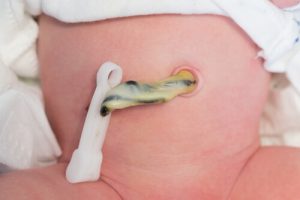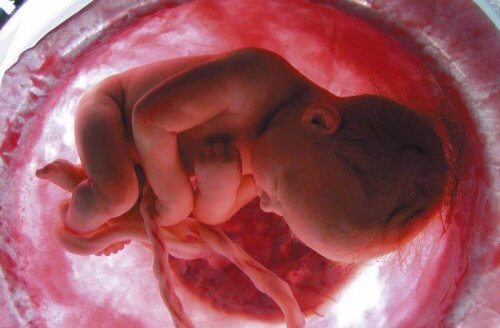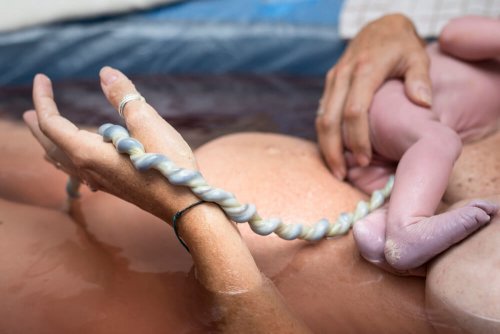The Umbilical Cord: What is it and what is its function?

The umbilical cord: Fundamental for fetal development
The length of the umbilical cord is about 20–22 inches. It has a spiral shape – like an old telephone cord – and, in general, contains between 10–12 spirals.
The cord contains two umbilical arteries and one umbilical vein. These are all immersed in a liquid called Wharton’s jelly.
This loose gel-like connective tissue gives the umbilical cord resistance and keeps it from getting tangled.
The two arteries and the vein are arranged in a triangle; the arteries form the base, with the vein forming the third point of the triangle.
Formation of the umbilical cord occurs between the fourth and eighth week of gestation. After the birth of your child, doctors will cut the umbilical cord, leaving a permanent scar: the belly button.
This, along with the expulsion of the placenta from the womb, reflect the transitory nature of these organs. They both form to carry out a specific and temporary function. Once fulfilled, these organs are discarded.
During your baby’s stay in your uterus, the umbilical cord represents your baby’s only source of nourishment, blood, and high oxygen levels. It forms a connection between the mother’s placenta and the fetus’s belly button.
Given the above-mentioned functions, the umbilical cord is indispensable for embryonic development.
The umbilical cord also physically demonstrates the union between mother and child in its maximum expression. For that reason and many more, mothers are a fundamental pillar in their children’s lives.

Umbilical cord function
Among the umbilical cord’s key functions for fetal development, we’d like to highlight the following:
- Nourishment: The umbilical cord carries nourishment provided by the mother’s placenta to the fetus.
- Breathing: It is the job of the umbilical cord to transport oxygen-rich blood to the fetus.
- Excretion: The carbon dioxide released by breathing as well as waste from nourishment are expelled through the umbilical cord.
- High stem cell content. Embryonic stem cells are undifferentiated cells, meaning they can convert into any type of cell. They can become skin cells, nervous tissue, or convert into cells that make up the heart, kidneys, etc. If stored, stem cells can be used to treat illnesses like childhood leukemia, spinal cord injury, or heart problems.
- The transmission of antibodies: Towards the end of pregnancy, the mother sends antibodies formed within her body to the fetus. These antibodies contribute to the formation of the baby’s immune system.
- The prevention of other pathologies: According to a report by Genome Biology, the analysis of umbilical cord cells in premature babies can help diagnose serious pulmonary alterations such as bronchopulmonary dysplasia.
As we can observe, the umbilical cord isn’t only a fundamental part of the creation of new life. It also provides a way to save lives.
The donation of umbilical cord blood is a painless process that can be performed immediately after birth.
“The umbilical cord physically demonstrates the union between mother and child in its maximum expression”
Details relating to umbilical cord care
There are many doubts that arise regarding caring for the umbilical cord after a baby’s birth. Let’s go over a few:
When is the right moment to cut the cord? Traditionally, medical professionals have cut the umbilical cord immediately after a baby’s birth.
However, the World Health Organization and other researchers suggest waiting between 30–120 seconds before severing the cord.
As a result, the possibility of the baby needing a blood transmission reduces, as does that of suffering an intravenous hemorrhage.
However, if you’re planning to donate umbilical cord blood, the cord will need to be cut immediately.

What does the caring of a newborn’s umbilical cord consist of? The piece of the umbilical cord that remains attached to your child’s belly button will dry up in a matter of days and fall off.
This usually occurs during the first or second day of life. Meanwhile, you should clean the area with isopropyl 70% alcohol and sterile gauze.
According to recent studies, caring for a newborn’s umbilical cord with these substances isn’t absolutely indispensable. You can also just keep the region dry.
However, in areas where the risk of bacteria is high, this cleaning process can help prevent possible infection.
Can I bathe my newborn? Yes, you can, but you must always gently dry the umbilical cord and surrounding area afterwards.
How can I be sure everything is okay? If you think the cord looks strange, or has a strange smell, is bleeding or oozing liquid, talk to you pediatrician.
A very small amount of bleeding is normal (spotting, small stains), but larger amounts should be brought to your doctor’s attention. He or she may prescribe antibiotics to avoid infection.
All cited sources were thoroughly reviewed by our team to ensure their quality, reliability, currency, and validity. The bibliography of this article was considered reliable and of academic or scientific accuracy.
- Heil, J. R. (2023). Embryology, Umbilical Cord. StatPearls. https://www.ncbi.nlm.nih.gov/books/NBK557490/
-
Basta, M. & Lipsett, B., J. (2022, 25 de julio). Anatomy, Abdomen and Pelvis: Umbilical Cord. StatPearls. https://www.ncbi.nlm.nih.gov/books/NBK557389/
- Krzyżanowski, A., Kwiatek, M., Gęca, T., Stupak, A., & Kwaśniewska, A. (2019). Modern Ultrasonography of the Umbilical Cord: Prenatal Diagnosis of Umbilical Cord Abnormalities and Assessement of Fetal Wellbeing. Medical Science Monitor, 25, 3170–3180. https://www.ncbi.nlm.nih.gov/pmc/articles/PMC6505057/
- Lara, J. M., Salgado, J., Carrasco, F. F., Del Río, P. C., Vázquez, M. D., & Rodríguez, L. (2018). Asistencia al parto inminente extrahospitalario. Actuaciones durante este proceso y cuidados a la madre y al recién nacido. Revista Española De Salud Pública, 92(92), 12. https://scielo.isciii.es/scielo.php?script=sci_arttext&pid=S1135-57272018000100306
- Holbrook, B. D., & Phelan, S. T. (2013). Umbilical cord prolapse. Obstetrics and Gynecology Clinics of North America, 40(1), 1–14. https://pubmed.ncbi.nlm.nih.gov/23466132/
- Organización Mundial de la Salud. (2014). Pinzamiento tardío del cordón umbilical para reducir la anemia en lactantes. https://apps.who.int/iris/handle/10665/120076
- Castellanos, J. L., Muñuzuri, A. P., Campillo, C. W. R., López, E. S., Fernández, I. M. G., Redondo, M. J., Gracia, S. R., & Sánchez-Luna, M. (2019). Recomendaciones para el cuidado del cordón umbilical en el recién nacido. Anales de Pediatría, 90(6), 401.e1-401.e5. https://www.sciencedirect.com/science/article/pii/S1695403319300700?via%3Dihub
- Casal, M. E. B., Córdoba, M. M. S., & Saborido, M. J. M. (2015). Prevención y detección precoz de la onfalitis en la visita puerperal. Nursing. https://www.elsevier.es/es-revista-nursing-20-articulo-prevencion-deteccion-precoz-onfalitis-visita-S0212538215002046
This text is provided for informational purposes only and does not replace consultation with a professional. If in doubt, consult your specialist.








